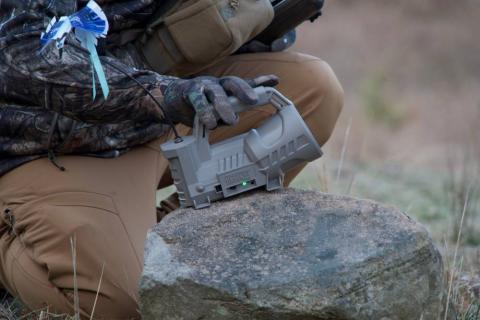Conversation, even between man and beast, is far more than just speaking words.

Bob Humphrey
When it comes to hearing turkey calls in the woods, it can sometimes be tough to tell humans from the real thing. There are some pretty good calls and callers out there nowadays, and some of the worst you hear are often uttered by the birds. But when you hunt a lot of public ground like I do, you quickly develop an ear for it, and once subtle clues become more obvious.
For example, you might hear a series of yelps that is pure in tone and perfect in pitch, leading you to believe it could only be a genuine hen. And it may well be. You hear it again, “Yelp, yelp, yelp, yelp, yelp,” and now you’re almost certain. But the third time you notice something. Each calling bout contains exactly the same number of yelps at precisely the same volume, uttered at evenly spaced intervals. The guy obviously has the notes down cold, but he’s a long way from being able to play a tune.
Learning to talk fluent turkey is not much different than learning a foreign language. You start with the basic vocabulary: Yelp, cluck, putt, etc. Next you begin putting words together to form short sentences: Kee-kee-run. Soon, with a modicum of practice most folks should be able to mimic the basic calls a turkey makes, like the plain yelp, the cluck and purr and so forth. Then they take to the field with great expectations of success, but soon fall on hard times when their message just doesn’t seem to be getting through. That’s because effective communication requires that you first be able to understand what the other person is saying, and then respond in appropriate manner. If you want to be a more effective turkey hunter, you need to go beyond basic vocabulary and learn conversational turkey.
Turkey 300
The prerequisite for this class is that you have mastered the basic calls or vocabulary of the wild turkey, and have at least some familiarity with composing brief sentences. Now we’re going to build those sentences into fluid conversation.
The plain yelp - something along the lines of 5-7 repetitive yelps given at a moderate cadence and volume - is often a good ice breaker. It’s like saying, “hola, bon jour,” or “Hello, anybody home?” Then a turkey gobbles in response. The novice turkey hunter is likely going to reply with those same 5-7 yelps. “Hello!” You can get away with that a time or two; even people do it. But if a person starts asking questions like, “How are you? What have you been up to? How’s the family?” and all you can respond with is “Hello,” they’re going to figure out pretty quickly that something isn’t right. A turkey’s brain is only the size of a walnut, but they are very proficient vocal communicators.
Espressivo

Communication includes not only what you are trying to say, but what you are trying to express. Again, just repeating the same phrase gets pretty boring. And even a crime thriller novel would seem pretty boring if read aloud in monotone. If you’re getting a positive response to your calls, maybe you can embellish them a little - what competition callers refer to as “dressing” your calls - by adding a few cutts to the beginning or end of your yelping bout. “Cutt-cutt-cutt, yelp...yelp...yelp... yelp.”
Now instead of “Hello,” you’re saying, “Hey, big fella, why don’t you come down and see me some time.” If you get an encouraging reply, you might get really risqué with some loud, aggressive cutting. “Take me, I’m yours!” Conversely, if the reaction is cold, you may want to respond in kind. Soften the volume or even face away. “Fine. Have it your way but I’m outta here.” Some guys just can’t take rejection.
Don’t just talk to the guys either, especially if they are in the company of other women. Imagine you let out a few neutral yelps and get a gobble in response. You: “Hello, anybody out there?” Him: “Yep, I’m right over here.” It sounds like you’re off to a good start, until his old lady chimes in with some louder yelps. She might be saying to you, “Yes, and I’m here too!” or to him, “And don’t you go getting any ideas.” Either way, it now seems like a no-win scenario, unless you’re willing to go catty on her. Give it right back. If she yelps five times, you yelp six, or seven. If she cutts, you cutt louder, and longer. She’ll either pull the tom away from you or lead him right to you, but if you do nothing, neither will happen and you’ll have no chance of him riding home in the back of your truck.
Tone Deaf
Effective verbal communication involves not just the words we say, but how we say them. Without the proper tone and inflection, the meaning can be lost or obscured. That’s why texting and e-mailing often results in misunderstandings, and why turkey hunters sometimes fail to convey the right message.
Most turkey hunters are familiar with the expression “taking a turkey’s temperature.” It involves gauging how interested a gobbler is in your calling by understanding how he reacts. You call, he gobbles back. You call again and he gobbles, twice, cutting you off before you finish. Right here old Mr. 5-7 yelps repeats the same sentence, quite possibly cooling the conversation. A more experienced hunter knows you’ve got to raise your voice, call more loudly and frenetically, giving the inflection that you, the hen, are just as fired up. Conversely, if the gobbler is merely offering a courtesy gobble in response to your pleadings, or goes mum, you’re often best to follow suit. Some guys don’t like aggressive women, others prefer aloof or even hard to get. Remember to let the turkey be your guide. You can argue with a hen but you should agree with a tom.
Paint a Picture
 By knowing some basic conversational phrases and sentences you can travel abroad and at least get directions to the tourist attractions and possibly order a meal. But if you really want to make a good impression on the natives you’ll need to be able to weave those sentences into paragraphs. In turkey hunting terms, that means not just conversing but creating a realistic sound scenario to clarify your meaning.
By knowing some basic conversational phrases and sentences you can travel abroad and at least get directions to the tourist attractions and possibly order a meal. But if you really want to make a good impression on the natives you’ll need to be able to weave those sentences into paragraphs. In turkey hunting terms, that means not just conversing but creating a realistic sound scenario to clarify your meaning.
A lone hen walking along contentedly clucking is kind of boring, and you’ll quickly run out of things to say if Old Tom doesn’t come right over. And if he’s not sure what you’re really implying, he may lose interest. Instead of just a single hen, try to sound like two hens who might be a little angry at one another. “You’ve been sniffing around Tom again, haven’t you?” one begins. “What I do in the back field is none of your business, Henrietta,” replies the other. “You stay away from him, and don’t come up to this corner of the woodlot anymore either.” That excitement could fire up even old Harvey Limbhanger.
A distant yelping bout could easily be misunderstood for several things. Follow it up with a few jake yelps or even a gobble or two and the picture becomes clearer. Playing the jealousy card might goad Old Tom into sharpening his spurs to open up a can on those perceived intruders.
Maybe you sense a sudden loss of confidence. He seemed fired up and started toward you but hung up part way. Convince him it’s not just one, but several hens contentedly feeding along by adding some scratching in the leaves.
Coda
The list of possibilities is limitless because every scenario, every interaction you have with a turkey is unique. Having a basic understanding of turkey vocabulary and the ability to recite it can sometimes get the job done. More often, it won’t. If you really want to win friends and influence turkeys, you’ve got to be able to speak their lingo, the more fluently the better. And while you’ll never be perfect, practice at least makes you better.






























